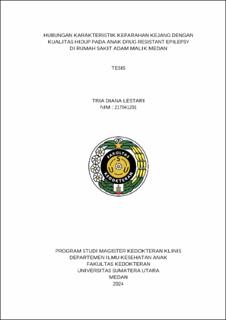Hubungan Karakteristik Keparahan Kejang dengan Kualitas Hidup pada Anak Drug Resistant Epilepsy di Rumah Sakit Adam Malik Medan
Relationship Between Seizure Severity Characteristics and Quality of Life in Children with Drug Resistant Epilepsy

Date
2024Author
Lestari, Tria Diana
Advisor(s)
Tanjung, Ika Citra Dewi
Metadata
Show full item recordAbstract
Background: Drug Resistant Epilepsy (DRE) is uncontrolled seizures despite receiving monotherapy or combination therapy. DRE increases the risk of premature death, injury, and significant reduction in quality of life.
Objective: To assess the association of seizure severity characteristics with quality of life of DRE children.
Methods: This cross-sectional study design involved 36 DRE patients aged 2-18 years at the Child Neurology Polyclinic of Adam Malik Hospital Medan from September to October 2024. Seizure severity characteristics were assessed using the Global Assessment of the Severity of Epilepsy (GASE) questionnaire instrument and quality of life assessment of DRE children using the Pediatric;s Quality of Life (PedsQL) general core parent proxy instrument. Categorical data were presented as proportions and the relationship between seizure severity characteristics and quality of life were analyzed using chi square test and multiple logistic regression test was used to assess the most influential variables.
Results: Children with severe physical activity impairment will tend to have a 20.4 times greater risk of impaired total quality of life compared to children with DRE with mild physical activity impairment or no activity impairment.
Conclusion: The seizure severity characteristic that most affects the quality of life of DRE children is activity impairment, especially in physical, emotional and social aspects.
